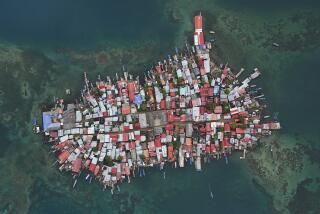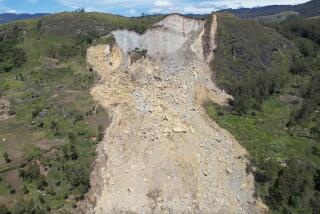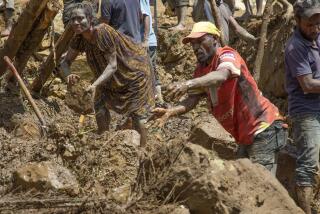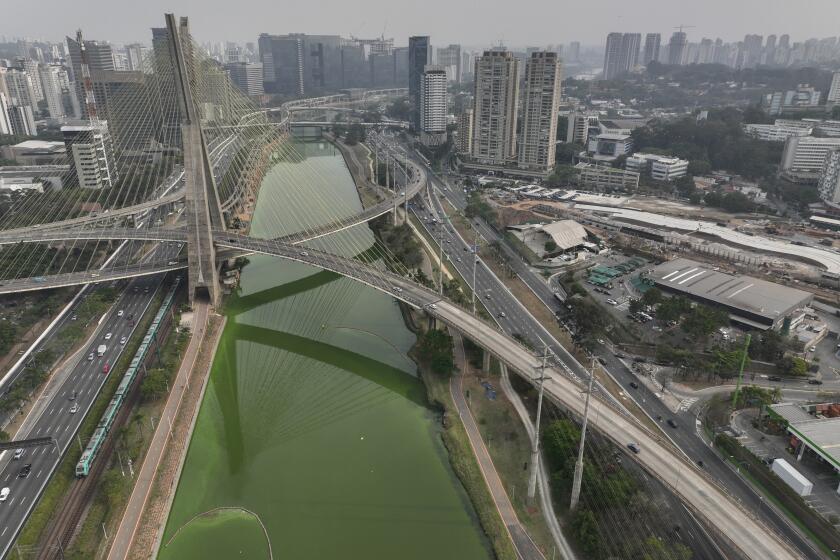Children Bore Brunt of Waves’ Deadly Fury
VANIMO, Papua New Guinea — As relief workers buried hundreds and the death toll rose significantly, fears grew here Monday that so many children fell victim to three killer waves that part of this island nation has, in effect, lost a generation of its people.
As many as 10,000 villagers lived along the 20-mile stretch of coast on the island’s northern shore where a tsunami hit Friday.
But by today, even as more survivors trickled out of the jungle, relief workers said they had buried about 1,400 bodies, most of them children or the elderly.
Thousands more may have perished, said Father Austen Crapp, director of the Roman Catholic mission that is leading rescue efforts. “There is no time for funerals,” he said from Aitape, the village near the center of the disaster. “There are too many bodies. We are just digging a big hole and putting them all in. I made a simple prayer and went on.”
Officially, the toll from the disaster is at least 700 dead. But John Tekwi, governor of West Sepik province, where the waves hit, said at least 3,000 people were killed, Australian Broadcasting Corp. reported.
Authorities have accounted for 3,000 of the estimated 10,000 people who lived in the affected area, but that still leaves at least 7,000 people with uncertain fates, said Lt. Col. Rod West, a pilot with the Australian air force, who noted, “We assume that the rest are dead or hiding in the jungle.”
West said that rescue crews in helicopters have been scouring the area, landing in clearings and finding themselves mobbed by survivors emerging from the jungle.
Villagers had just minutes to react when an undersea, magnitude-7 earthquake launched three giant waves Friday.
Among the injured, many were bashed by uprooted coconut trees and debris carried by the water.
In Aitape, the beds and floors of the mission’s clinic and schools are crowded with injured people in shock, with broken backs and gashed faces and thighbones snapped in half.
Helicopters airlifted the wounded from hillsides--there are few roads--and ferried them to hospitals in other towns.
Aitape is so remote that until the Royal Australian Air Force set up a field hospital in nearby Vanimo on Monday, the closest medical facility was a 45-minute plane ride away.
Papua New Guinea Prime Minister William Skate visited the disaster area Monday and appealed for more doctors, food and fresh water.
“People are lost, they are confused, they really don’t know what has hit them,” Skate told Australian journalists. “I am deeply saddened by what has happened here. Let us pray for those we have lost.”
Fishermen, laboring in the tropical heat, used their nets to retrieve victims floating in Sissano Lagoon, which is failing to drain because it is badly clogged with debris and bodies. Rescue workers hurriedly buried corpses to forestall the spread of disease and contamination of the water. Villagers said saltwater crocodiles that live along the coast are feeding on the corpses.
At the Vanimo field hospital, Australian military doctors and nurses tended to the survivors, setting bones and performing amputations under a tent set up in a sports field.
The International Red Cross is bringing in fresh water, food and tools to help villagers rebuild their houses. But the remoteness of the hard-hit region has hampered emergency officials from Papua New Guinea, Australia and New Zealand, who are coordinating a rescue operation.
The first of three Royal Australian Air Force C-130 Hercules transport aircraft arrived in Vanimo on Monday with emergency supplies, including the field hospital and a 100-member team of doctors, nurses and engineers.
Papua New Guinea, with a population of 4 million, occupies the eastern half of the island of New Guinea, about 90 miles north of Australia, where some live a near-Stone Age existence in the jungles and swamps.
The original temblor and the many aftershocks have brought some indigenous people out of their jungle homes and to the coast. The bushmen, Australian officials say, are helping to bury the dead.
Several communities were wiped out, with nothing remaining but a few coconut trees and a stretch of smooth sand.
Reestablishing the villages is, technically speaking, simple, said Janet Philemon, secretary general of the Red Cross in Papua New Guinea. Traditional houses are made of jungle materials, with thatched roofs and woven palm walls.
But what will be most difficult is reviving communities that have lost so many people, especially youngsters--most of whom were home on a holiday when the wave struck, rather than in mission schools farther inland where they might have been safe. So many children died that some schools are not expected to reopen.
“What chance would a 2-year-old or 3-year-old child have?” when trapped in a tsunami, Crapp asked. “It wipes out everything, destroys everything, bounces people off trees, off obstacles, bowls them into the lagoon before it turns, rushing back out to sea.
“The children may be hiding somewhere; we hope so. But the fear is that they have drowned,” he said.
Philemon observed that for survivors, “This has been an enormous trauma. They are still trying to find their groups and figure out what to do next.”
One of the first decisions must be where to resettle. Crapp, a Franciscan missionary who has served in the area for 36 years, guesses the villagers won’t return to the shore.
“They know the sea, but now they don’t trust it,” he said. “This will haunt them for a long time.”
Filkins reported from Vanimo and Farley from Shanghai. Associated Press contributed to this report.
More to Read
Sign up for Essential California
The most important California stories and recommendations in your inbox every morning.
You may occasionally receive promotional content from the Los Angeles Times.










